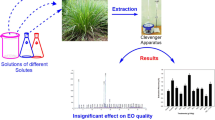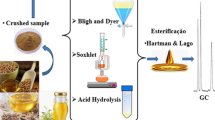Abstract
An optimized microwave-assisted extraction (MAE) method was evaluated through repeatability, recovery and efficiency testing. The repeatability tests, performed by three users over time, were not significantly different. The recovery of lignan throughout the extraction, preparation and analysis steps is 97.5% with a coefficient of variation <1%. The MAE method is efficient for extracting lignans from the plant matrix, and it achieves significantly higher extraction yields than the two established reference methods. The applicability of the MAE method was demonstrated by extracting lignans from a variety of plant samples. The secoisolariciresinol diglucoside (SDG) content of seven flaxseed cultivars grown in Saint-Mathieu-de-Beloeil, QC, in 2009 ranged from 14.6 to 18.9 mg SDG per gram of seed. Flax hulls produced in Winchester, ON, in 2010 were very rich in lignan; their SDG content was 40.0 mg/g of flax hull. Sesame seeds contained 0.18–1.89 mg SECO (aglycone of SDG) per gram of seed, with significant differences among black, white and brown sesame seed. Chia seeds contained 0.99–1.29 mg SECO per gram of seed, with significant differences among batches of seeds. Sunflower seeds had 0.046 mg SECO per gram of sample and almonds had 0.029 mg SDG per gram of sample. The optimized and evaluated MAE method is recommended for the general analytical quantification of lignans in plant samples.







Similar content being viewed by others
References
Adolphe JL, Whiting SJ, Juurlink BHJ, Thorpe LU, Alcorn J (2010) Health effects with consumption of the flax lignan secoisolariciresinol diglucoside. Br J Nutr 103:929–938. doi:10.1017/S0007114509992753
Anonymous (2008) Flaxseed quality in Canada—Canadian flax quality shows long term consistency and improvement. Canadian Grain Commission. http://www.grainscanada.gc.ca/flax-lin/trend-tendance/qfc-qlc-eng.htm
Anonymous (2011) Appendix C—Operating procedures for the registration of a flax cultivar for production in Western Canada. Prairie Recommending Committee for Oil Seeds (PRCO). http://www.pgdc.ca/pdfs/oc/2011%20PRCO%20Operating%20Procedures%20Appendix%20C%20%28Flax%29.pdf. Accessed March 2011, pp 1–18
Beejmohun V, Fliniaux O, Grand E, Lamblin F, Bensaddek L, Christen P, Kovensky J, Fliniaux MA, Mesnard F (2007) Microwave-assisted extraction of the main phenolic compounds in flaxseed. Phytochem Anal 18:275–282
Daun JK, Barthet VJ, Chornick TL, Duguid SD (2003) Structure, composition, and variety development of flaxseed. In: Thompson LU, Cunnane SC (eds) Flaxseed in human nutrition. AOCS, Champaign, pp 1–40
Dweck AC (2000) The folklore and cosmetic use of various Salvia species. In: Kintzisos SE (ed) Sage: the genus Salvia. Harwood Academic, Amsterdam, pp 1–26
Eliasson C, Kamal-Eldin A, Andersson R, Aman P (2003) High-performance liquid chromatographic analysis of secoisolariciresinol diglucoside and hydroxycinnamic acid glucosides in flaxseed by alkaline extraction. J Chromatogr A 1012:151–159
Ford JD, Huang KS, Wang HB, Davin LB, Lewis NG (2001) Biosynthetic pathway to the cancer chemopreventive secoisolariciresinol diglucoside-hydroxymethyl glutaryl ester-linked lignan oligomers in flax (Linum usitatissimum) seed. J Nat Prod 64:1388–1397
Johnsson P, Kamal-Eldin A, Lundgren LN, Aman P (2000) HPLC method for analysis of secoisolariciresinol diglucoside in flaxseeds. J Agric Food Chem 48:5216–5219
Johnsson P, Peerlkamp N, Kamal-Eldin A, Andersson RE, Andersson R, Lundgren LN, Aman P (2002) Polymeric fractions containing phenol glucosides in flaxseed. Food Chemistry 76:207–212
Kamal-Eldin A, Peerlkamp N, Johnsson P, Andersson R, Andersson RE, Lundgren LN, Amar P (2001) An oligomer from flaxseed composed of secoisolariciresinoldiglucoside and 3-hydroxy-3-methyl glutaric acid residues. Phytochemistry 58:587–590
Madhusudhan B, Wiesenborn D, Schwarz J, Tostenson K, Gillespie J (2000) A dry mechanical method for concentrating the lignan secoisolariciresinol diglucoside in flaxseed. Lebensmittel-Wissenschaft and Technologie 33:268–275
Milder IEJ, Arts ICW, Venema DP, Lasaroms JJP, Wahala K, Hollman PCH (2004) Optimization of a liquid chromatography–tandem mass spectrometry method for quantification of the plant lignans secoisolariciresinol, matairesinol, lariciresinol, and pinoresinol in foods. J Agric Food Chem 52:4643–4651
Milder IEJ, Arts ICW, van de Putte B, Venema DP, Hollman PCH (2005) Lignan contents of Dutch plant foods: a database including lariciresinol, pinoresinol, secoisolariciresinol and matairesinol. Br J Nutr 93:393–402
Moazzami A, Kamal-Eldin A (2006) Sesame seed is a rich source of dietary lignans. Journal of the American Oil Chemists’ Society 83:719–723. doi:10.1007/s11746-006-5029-7
Moazzami AA, Andersson RE, Kamal-Eldin A (2006) HPLC analysis of sesaminol glucosides in sesame seeds. J Agric Food Chem 54:633–638. doi:10.1021/jf051541g
Nemes SM, Orsat V (2009) Microwave-assisted extraction of secoisolariciresinol diglucoside—method development. Food and Bioprocess Technology 1–9. doi:10.1007/s11947-009-0213-z
Nemes SM, Orsat V (2010) Screening the experimental domain for the microwave-assisted extraction of secoisolariciresinol diglucoside from flaxseed prior to optimization procedures. Food and Bioprocess Technology 3:300–307. doi:10.1007/s11947-009-0212-0
Nollet LML (2000) Food analysis by HPLC, 2nd edn. Marcel Dekker, New York
Oomah BD, Hosseinian FS (2008) Phytoestrogens. In: Hurst WJ (ed) Methods of analysis for functional foods and nutraceuticals. CRC, Boca Raton, pp 1–84
Oomah BD, Sitter L (2009) Characteristics of flaxseed hull oil. Food Chemistry 114:623–628
Penalvo JL, Haajanen KM, Botting N, Adlercreutz H (2005) Quantification of lignans in food using isotope dilution gas chromatography/mass spectrometry. J Agric Food Chem 53:9342–9347
Penalvo JL, Adlercreutz H, Uehara M, Ristimaki A, Watanabe S (2008) Lignan content of selected foods from Japan. J Agric Food Chem 56:401–409
Peterson J, Dwyer J, Adlercreutz H, Scalbert A, Jacques P, McCullough ML (2010) Dietary lignans: physiology and potential for cardiovascular disease risk reduction. Nutr Rev 68:571–603. doi:10.1111/j.1753-4887.2010.00319.x
Plattner RD, Powell RG (1978) A secoisolariciresinol branched fatty diester from Salvia plebeia seed. Phytochemistry 17:149–150. doi:10.1016/s0031-9422(00)89701-0
Powell RG, Plattner RD (1976) Structure of a secoisolariciresinol diester from Salvia plebeia seed. Phytochemistry 15:1963–1965
Puvirajah AS (2011) Quality of Western Canadian Flaxseed 2010. Canadian Grain Commission. www.grainscanada.gc.ca, pp 1–14
Schwartz H, Sontag G, Plumb J (2009) Inventory of phytoestrogen databases. Food Chemistry 113:736–747
Sicilia T, Niemeyer HB, Honig DM, Metzler M (2003) Identification and stereochemical characterization of lignans in flaxseed and pumpkin seeds. J Agric Food Chem 51:1181
Smeds AI, Eklund PC, Sjoholm RE, Willfor SM, Nishibe S, Deyama T, Holmbom BR (2007) Quantification of a broad spectrum of lignans in cereals, oilseeds, and nuts. J Agric Food Chem 55:1337–1346
Smeds AI, Jauhiainen L, Tuomola E, Peltonen-Sainio P (2009) Characterization of variation in the lignan content and composition of winter rye, spring wheat, and spring oat. J Agric Food Chem 57:5837–5842. doi:10.1021/jf9004274
Spence JD, Thornton T, Muir AD, Westcott ND (2003) The effect of flax seed cultivars with differing content of α-linolenic acid and lignans on responses to mental stress. J Am Coll Nutr 22:494–501
Struijs K, Vincken J-P, Verhoef R, van Oostveen-van Casteren WHM, Voragen AGJ, Gruppen H (2007) The flavonoid herbacetin diglucoside as a constituent of the lignan macromolecule from flaxseed hulls. Phytochemistry 68:1227–1235
Struijs K, Vincken JP, Verhoef R, Voragen AGJ, Gruppen H (2008) Hydroxycinnamic acids are ester-linked directly to glucosyl moieties within the lignan macromolecule from flaxseed hulls. Phytochemistry 69:1250–1260
Struijs K, Vincken J-P, Doeswijk TG, Voragen AGJ, Gruppen H (2009) The chain length of lignan macromolecule from flaxseed hulls is determined by the incorporation of coumaric acid glucosides and ferulic acid glucosides. Phytochemistry 70:262–269. doi:10.1016/j.phytochem.2008.12.015
Thompson LU, Rickard SE, Cheung F, Kenaschuk EO, Obermeyer WR (1997) Variability in anticancer lignan levels in flaxseed. Nutrition and Cancer 27:26–30. doi:10.1080/01635589709514497
Thompson LU, Boucher BA, Zhen L, Cotterchio M, Kreiger N (2006) Phytoestrogen content of foods consumed in Canada, including isoflavones, lignans, and coumestan. Nutrition & Cancer 54:184–201
Thompson LU, Boucher BA, Cotterchio M, Kreiger N, Liu Z (2007) Dietary phytoestrogens, including isoflavones, lignans, and coumestrol, in nonvitamin, nonmineral supplements commonly consumed by women in Canada. Nutrition and Cancer 59:176–184
Westcott ND, Muir AD (2003) Chemical studies on the constituens of Linum spp. In: Muir AD, Westcott ND (eds) Flax: the genus Linum. Routledge, London, pp 55–73
Westcott ND, Muir AD, Lafond G, McAndrew DW, May W, Shirtliffe S, Bruulsema TW (2002) Factors affecting the concentration of a nutraceutical lignan in flaxseed. In: Bruulsema TW (ed) Proceedings of the Symposium on Fertilizing Crops for Functional Foods, Potash & Phosphate Institute/Potash & Phosphate Institute of Canada (PPI/PPIC), Indianapolis, Indiana, USA, pp 1–4
Zhang W, Xu S (2007) Microwave-assisted extraction of secoisolariciresinol diglucoside from flaxseed hull. Journal of the Science of Food and Agriculture 87:1455–1462
Acknowledgements
The authors thank the Natural Sciences and Engineering Research Council of Canada (NSERC), the Fonds Québécois de la Recherche sur la Nature et les Technologies (FQRNT), the Canada Foundation for Innovation (CFI) and the ABIP programme of Agriculture and Agri-Food Canada for the financial support. Thanks are due to Dr. Nam Fong Han from Natunola Health Inc. for providing the flax hulls and to Mr. Yves Dion from Centre de Recherche sur les Grains (CEROM) for providing the flaxseed cultivars. The help of Miss Yanti Yusoff, Mr. Maxime Ouelette-Payeur and Mr. Scott Hong Liang for carrying out the MAE repeatability tests is much appreciated.
Author information
Authors and Affiliations
Corresponding author
Rights and permissions
About this article
Cite this article
Nemes, S.M., Orsat, V. Evaluation of a Microwave-Assisted Extraction Method for Lignan Quantification in Flaxseed Cultivars and Selected Oil Seeds. Food Anal. Methods 5, 551–563 (2012). https://doi.org/10.1007/s12161-011-9281-6
Received:
Accepted:
Published:
Issue Date:
DOI: https://doi.org/10.1007/s12161-011-9281-6




